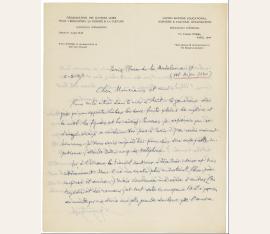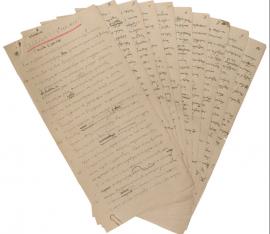Greek writer (1883-1957) Autograph letter signed ("NKazantzaki"). Paris. 06.08.1947. 4to. 2 pp. Addendum: TLS by the author's widow, Eleni Kazantzakis. Geneva, 25 May 1973. Folio. 1 p.
$ 19,138 / 18.000 €
(34023/BN29722)
Important, pessimistic letter to the Swedish Hellenist Börje Knös (1883-1970), whose visit he anticipates: "Cher monsieur et ami! Nous voilà dans le mois d'Août - le généreux dieu grec qui nous apporte là-bas les deux fruits pleins de mystère et de miel: les figues et les raisins. Pourrais-je espérer que ce dieu généreux va conduire Vos pas à Paris? J'en serais vraiment heureux [...] Ici, à Unesco, le travail commencé à être intense et trés intéressant. Mais il ne me reste plus un instant libre pour respirer et écrire; j'avais commencé une série d'oeuvres (des tragédies et des romans) et tout reste en suspens.
Et il n'y a rien au monde qui me donne une plus grande douleur que l'oeuvre inachevée. Je ne voudrais pas mourir sans avoir pu sauver toute mon âme, en l'exprimant par des mots clairs, durs et enflammées. Comme l'Ulysse de mon Odyssée je ne voudrais laisser à la mort comme butin que quelques os et un peu de chair desséchée [...]." Undoubtedly under the impression of the Civil War in Greece, Kazantzakis continues: "Aura-t-on le temps de jouir encore un peu de cette vie unique et éphémère? La lumière de plus en plus s'assombrit; notre pauvre planète est entrée dans une ombre envahissante; l'esprit humain subit une éclipse - notre responsabilité est grande; chaque étincelle de lumière qui existe encore et vacille doit être sauvée: [Ho lógos ho spermatinós (gr.)], la Parole ensemençant! Chaque jour je deviens plus pessimiste et plus conscient de la responsabilité humaine. Garder cette etincelle, ne pas la laisser s'eteindre! Combattre la nuit horrible avec cette petite lumière. Rester debout, les yeux ouverts, l'esprit en sentinelle. - Cher monsieur et ami, j'espère Vous revoir bientôt et pouvoir parler avec Vous et nous promener aux bords de l'abîme sans trébucher [...]". - On stationery with printed UNESCO letterhead. Kazantzakis was then head of the Unesco's classics translation bureau. All the famous novels and tragedies on which his fame rests were written in exile in Paris. - Includes a TLS by the widow Eleni Kazantzakis, in which she sends he late husband's letter to a Mr. Dubois for a charity auction of the "Association Suisse en Faveur des Enfants Infirmes Moteurs Cérébraux"..
Greek writer (1883-1957) "Hoplopoiia, Iliada Sigma (S. 368-618)". Autograph manuscript signed ("N. Kazantzaki"). No place. 10 ff. of ms., with an additional f. of notes. 11 ff. altogether, written in ink on one side only, narrow folio format (c. 35 x 17 cm).
$ 37,212 / 35.000 €
(45333/BN31749)
Complete manuscript of the famous "Hoplopoiia" section of Kazantzakis's Iliad translation: a pivotal part of the 18th book (rhapsody sigma) of Homer's epic. Kazantzakis and the scholar J. T. Kakridis collaborated on this metrical translation from classical Greek into the modern demotic language over a 14-year period. When it was privately printed in 1955, the controversial effort was hailed as "'living' poetry, through which the modern Greeks will be able to grasp much of the vigour, the passion, and the values of the heroic world of the Iliad" (C.
A. Trypanis, The Classical Review 8 [1958], p. 280). The "Hoplopoiia", or the "Making of Armor for Achilles", is one of the most famous parts of Homer's poem: After the death of Patroclus has convinced Achilles to re-enter battle and avenge his friend, his mother Thetis seeks out the smithing god Hephaistus, who fashions a new set of armour for him, among which is a magnificently wrought shield. The detailed description (ekphrasis) of this shield, which takes up most of the present ms., is regarded as one of the paramount passages in Western literature: starting from the center and moving outward, the shield shows first the heavenly bodies (Earth, sky and sea, the sun, the moon and the constellations), then a city at peace (a wedding; a lawsuit; council) and at war (opposing armies; the gods; an ambush); country life (ploughing and reaping; vintage; a herd of cattle attacked by lions; a sheep farm); dancing youths and maidens; and finally, the all-enclosing ocean stream. In essence, the shield offers a physical encapsulation of the entire world: the various layers of this microcosm present a series of contrasts, antitheses that show the basic forms of a civilized, essentially orderly life. Leading up to Achilles's return to battle and one of the bloodiest parts of the Iliad, the Shield Ekphrasis also provides a moment of calm before the storm. - Traces of horizontal folds. Numerous revisions, corrections, and insertions in ink and pencil; caption "Iliada 18 (S. 368-618)" broadly underlined in red crayon. In the final page of notes (written on the reverse of a leaf on which the beginning of the translation has been struck out), Kazantzakis states that this version is not to be considered final and will require revisions as to orthography and accentuation. While the present ms. was probably composed and revised over a period of several years (the variations in pen type and ductus pointing to at least three main stages), the statement that work had been ongoing for three years suggests a time frame around the year 1944. Includes Certificate of Authenticity, issued by Spanos Rare Books, Athens..


